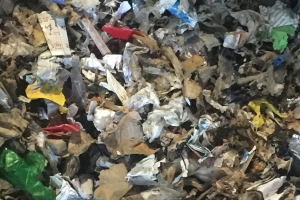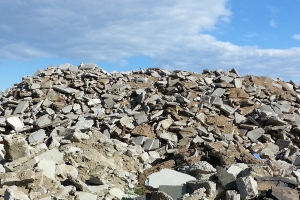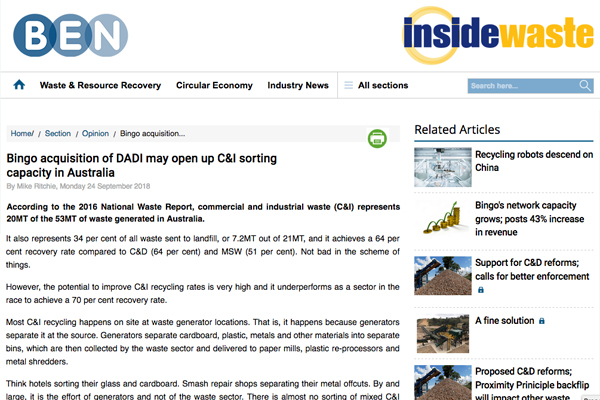Bingo acquisition of DADI may open up C&I sorting capacity in Australia
By Mike Ritchie, MRA Consulting Group

According to the 2016 National Waste Report, Commercial and Industrial waste (C&I) represents 20 MT of the 53 MT of waste generated in Australia (or 40% of generation). It also represents 34% of all waste sent to landfill (or 7.2MT out of 21MT) and achieves a 64% recovery rate compared to C&D (64%) and MSW (51%).
Not bad in the scheme of things.
However, the potential to improve C&I recycling rates is very high and it underperforms as a sector in the race to achieve a 70% recovery rate.
Most C&I recycling happens on site at waste generator locations. That is, it happens because generators separate it at the source. Generators separate cardboard, plastic, metals and other materials into separate bins which are then collected by the waste sector and delivered to paper mills, plastic re-processors and metal shredders.
Think hotels sorting their glass and cardboard. Smash repair shops separating their metal offcuts. By and large It is the effort of generators and not of the waste sector.
There is almost no sorting of mixed C&I waste in Australia.
There are only three small facilities in Sydney (SUEZ, Waste Free and Doyle Bros) sorting mixed commercial waste into reusable products for sale. And this only happens in Sydney because of the high cost of landfill (around $300/t) driven by the landfill levy which is currently at $140.20/t.
And yet there are hundreds of mixed C&D facilities across Australia sorting mixed C&D waste.
Why?
The difference is a result of homogeneity, weight and markets.
 C&D waste tends to be more homogenous with large percentages of concrete, steel and soil. These are relatively easily separated. C&D waste is also relatively heavy and therefore more responsive to landfill levy price signals. There are also robust markets for recycled concrete, steel and the like.
C&D waste tends to be more homogenous with large percentages of concrete, steel and soil. These are relatively easily separated. C&D waste is also relatively heavy and therefore more responsive to landfill levy price signals. There are also robust markets for recycled concrete, steel and the like.
Commercial waste does not have these advantages. It tends to be more heterogenous (think fibre, plastic, food, textiles, pallets, e-waste and glass) and on average is about a third of the weight per m3 than C&D waste. The markets for C&I waste are however quite good if you can sort the material into its component streams. While mixed fibre and mixed plastic have taken a hit due to the China National Sword policy there are still good prices for clean cardboard, newsprint, PET and HDPE plastics, aluminium, steel and some other streams.
The challenge is to develop commercially viable sorting systems that can recover these streams. So far, the industry has largely avoided C&I sorting as too hard.
We are seeing a big move towards waste derived, engineered fuels, i.e. turning mixed dry C&I and C&D waste into Processed Engineered Fuel. But not towards treating materials recovered from C&I waste as commodities.
A couple of AWT and MRF plants take mixed C&I waste in small quantities to sort out valuable products. Remondis tried to build a big C&I sorting platform but could not get planning approval for the site they chose.
In Sydney and Melbourne, we have seen Bingo utilising its C&D sorting systems to sort mixed C&I waste and thereby compete with traditional C&I collectors. Therefore Bingo, in contrast to traditional collectors, is seeking to offer diversion from landfill for mixed C&I waste streams. The trend in recent tenders has seen Bingo win a number of commercial waste contracts on the back of its diversion from landfill offering. The recently announced acquisition of DADI by Bingo includes significant recycling infrastructure, such as the Genesis Waste Facility at Eastern Creek, and is therefore expected to strengthen Bingo’s position and more importantly, offer waste generators further opportunities for recovering mixed C&I.
It remains to be seen whether the traditional waste collectors move into C&I sorting at all. Certainly, the economic drivers (levy and landfill prices, government grants), the policy drivers (such as diversion targets, NABERS and Green Star Ratings) and the availability of markets (domestic and international for both sorted streams and PEF) suggest that a more systematic and sustained move into C&I sorting should occur.
As always, I welcome your feedback on this, or any other topic on ‘The Tipping Point’.
This article has been published by the following media outlets:





